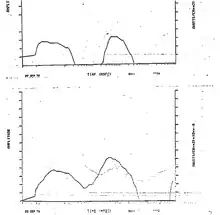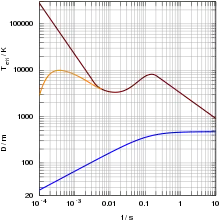Bhangmeter
A bhangmeter is a non-imaging radiometer installed on reconnaissance and navigation satellites to detect atmospheric nuclear detonations and determine the yield of the nuclear weapon.[1] They are also installed on some armored fighting vehicles, in particular NBC reconnaissance vehicles, in order to help detect, localise and analyse tactical nuclear detonations. They are often used alongside pressure and sound sensors in this role in addition to standard radiation sensors. Some nuclear bunkers and military facilities may also be equipped with such sensors alongside seismic event detectors.
The bhangmeter was developed at Los Alamos National Laboratory by a team lead by Herman Hoerlin.[2]
History
The bhangmeter was invented, and the first proof-of-concept device was built, in 1948 to measure the nuclear test detonations of Operation Sandstone. Prototype and production instruments were later built by EG&G, and the name "bhangmeter" was coined in 1950.[3] Bhangmeters became standard instruments used to observe US nuclear tests. A Mod II bhangmeter was developed to observe the detonations of Operation Buster-Jangle (1951) and Operation Tumbler-Snapper (1952).[4] These tests lay the groundwork for a large deployment of nationwide North American bhangmeters with the Bomb Alarm System (1961-1967).
US president John F. Kennedy and the First Secretary of the Communist Party of the Soviet Union Nikita Khrushchev signed the Partial Test Ban Treaty on August 5, 1963,[5] under the condition that each party could use its own technical means to monitor the ban on nuclear testing in the atmosphere or in outer space.[6]
Bhangmeters were first installed, in 1961, aboard a modified US KC-135A aircraft monitoring the pre-announced Soviet test of Tsar Bomba.[7]

The Vela satellites were the first space-based observation devices jointly developed by the U.S. Air Force and the Atomic Energy Commission. The first generation of Vela satellites were not equipped with bhangmeters but with X-ray sensors to detect the intense single pulse of X-rays produced by a nuclear explosion.[8] The first satellites which incorporated bhangmeters were the Advanced Vela satellites.
Since 1980, bhangmeters are part of US GPS navigation satellites.[9][10][11]
Description

The silicon photodiode sensors are designed to detect the distinctive bright double pulse of visible light that is emitted from atmospheric nuclear weapons explosions.[2] This signature consists of a short and intense flash lasting around 1 millisecond, followed by a second much more prolonged and less intense emission of light taking a fraction of a second to several seconds to build up.[12] This signature, with a double intensity maximum, is characteristic of atmospheric nuclear explosions and is the result of the Earth's atmosphere becoming opaque to visible light and transparent again as the explosion's shock wave travels through it.[10]
The effect occurs because the surface of the early fireball is quickly overtaken by the expanding "case shock", the atmospheric shock wave composed of the ionised plasma of what was once the casing and other matter of the device.[13] Although it emits a considerable amount of light itself, it is opaque and prevents the far brighter fireball from shining through. The net result recorded is a decrease of the light visible from outer space as the shock wave expands, producing the first peak recorded by the bhangmeter.
As it expands, the shock wave cools off and becomes less opaque to the visible light produced by the inner fireball. The bhangmeter starts eventually to record an increase in visible light intensity. The expansion of the fireball leads to an increase of its surface area and consequently an increase of the amount of visible light radiated off to space. The fireball continuing to cool down, the amount of light eventually starts to decrease, causing the second peak observed by the bhangmeter. The time between the first and second peaks can be used to determine its nuclear yield.[14]
The effect is unambiguous for explosions below about 30 kilometres (19 mi) altitude, but above this height a more ambiguous single pulse is produced.[15]
Origin of the name
The name of the detector is a pun,[3] which was bestowed upon it by Fred Reines, one of the scientists working on the project. The name is derived from the Hindi word "bhang", a locally grown variety of cannabis which is smoked or drunk to induce intoxicating effects, the joke being that one would have to be on drugs to believe the bhangmeter detectors would work properly. This is in contrast to a "bangmeter" one might associate with detection of nuclear explosions.[3]
References
- "Bulletin of Science, Technology & Society". Pergamon Press. 1985. Cite journal requires
|journal=(help) - Burr, William; Cohen, Avner; De Geer, Lars-Erik; Gilinsky, Victor; Polakow-Suransky, Sasha; Sokolski, Henry; Weiss, Leonard; Wright, Christopher (September 22, 2019). "Blast From the Past". Foreign Policy magazine. Retrieved June 23, 2020.
- Ogle, William E. (October 1985). "Bhangmeter — Prologue" (PDF). An account of the return to Nuclear Weapons testing by the United States after the test moratorium 1958-1961. United States Department of Energy — NV 291. p. 67. Archived from the original (PDF) on 2009-01-19. Retrieved 18 December 2008.
- Grier, Herbert (1953). "Operation Tumbler-Snapper, Nevada Proving Grounds, April–June 1952, Project 12.1 — Bhangmeter Mod II". EG&G. Archived from the original on 2015-06-29. Retrieved 2012-08-29.
- "Limited Test Ban Treaty". U.S. Department of State. 1963.
- Bell, Aaron J. (2002). Analysis of GPS Satellite Allocation for The United States Nuclear Detonation Detection System (USNDS). Air Force Institute Of Technology.
- Johnston, Robert (2009). "Multimegaton Weapons". Retrieved 19 June 2012.
- Gruntman, Mike (2004). Blazing the trail: the early history of spacecraft and rocketry. American Institute of Aeronautics and Astronautics, Inc. ISBN 1-56347-705-X.
- Richelson, Jeffrey (November–December 1998). "Verification: the ways and means". Bulletin of the Atomic Scientists: 54.CS1 maint: ref=harv (link)
- Goldblat, Jozef; Cox, David (1988). "Means of nuclear test ban verification". Nuclear weapon tests: prohibition or limitation?. Oxford: Oxford University Press. p. 239. ISBN 9780198291206. Retrieved 16 June 2012.
- "GPS timeline". Archived from the original on 2010-02-13. Retrieved 16 June 2012.
- Hafemeister, David. "Science and Society Test IX: Technical Means of Verification". Retrieved 16 June 2012.
- NUCLEAR EVENTS AND THEIR CONSEQUENCES by the Borden institute..."case shock"
- Forden, Geoffrey (2006). "A Constellation of Satellites for Shared Missile Launch Surveillance" (PDF). MIT’s Program on Science, Technology, and Society. Retrieved 17 June 2012.
- Angelo, Josepha A. Jr. (2004). Nuclear Technology. Greenwood Press. pp. 304–306. ISBN 9781573563369.
Further reading
- Tsipis, Kosta; Hafemeister, David W.; Janeway, Penny (1986). Arms control verification: the technologies that make it possible. Washington: Pergamon-Brassey's International Defense Publishers. ISBN 9780080331720.
- Priedhorsky, William C. (2003). "Eyes in Space Sensors for treaty verification and basic research" (PDF). Los Alamos Science. 28. Retrieved 17 June 2012.
- Higbie, Paul R.; Blocker, Norman K. (1993). The nuclear detonation detection system on the GPS satellites (PDF). Los Alamos National Laboratory. Retrieved 17 June 2012.
- Barasch, Guy E. (November 1979). Light Flash Produced by an Atmospheric Nuclear Explosion (PDF). LASL-79-84. Los Alamos National Laboratory.
- US Army (1952). Operation Ivy Final Report Joint Task Force 132 (PDF).